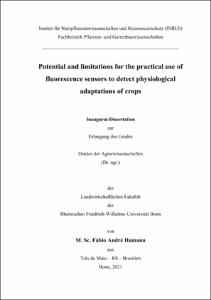Hamann, Fábio André: Potential and limitations for the practical use of fluorescence sensors to detect physiological adaptations of crops. - Bonn, 2021. - Dissertation, Rheinische Friedrich-Wilhelms-Universität Bonn.
Online-Ausgabe in bonndoc: https://nbn-resolving.org/urn:nbn:de:hbz:5-62596
Online-Ausgabe in bonndoc: https://nbn-resolving.org/urn:nbn:de:hbz:5-62596
@phdthesis{handle:20.500.11811/9159,
urn: https://nbn-resolving.org/urn:nbn:de:hbz:5-62596,
author = {{Fábio André Hamann}},
title = {Potential and limitations for the practical use of fluorescence sensors to detect physiological adaptations of crops},
school = {Rheinische Friedrich-Wilhelms-Universität Bonn},
year = 2021,
month = jun,
note = {The key objective of the present work was to evaluate the potential and limitations for the practical use of fluorescence sensors to detect physiological responses of crops to abiotic stresses, and the crop adaptations to these constrain factors. For this purpose, we investigated apple plants (Malus domestica Borkh.) grown under water deficit or different lighting systems, and barley cultivars (Hordeum vulgare L.) cultivated in the field and fertilised with different nitrogen levels. The outcome of the three single chapters is as follows:
1. In the first study, we investigated the influence of water shortage and light quality provide either by light emitting diodes (LED) or compact fluorescence lamps (CFL) on physiological and biochemical parameters of apple seedlings. Stress responses were assessed by fluorescence indices to non-destructively evaluate the suitability and practicability of portable sensors. Nitrogen Balance Index (NBI) and Nitrogen Balance Index with Red light excitation (NBI_R) showed similar patterns as chlorophyll (Chl) content, with higher values for plants under CFL. Flavonol Indices (Flav_Dx and Flav_Mx) were higher on plants cultivated under LEDs. Stomatal conductance (Gs) and maximal photo-chemical efficiency (Fv/Fm) were lower on plants grown under LED. Particular attention should be given to fluorescence indices related to nitrogen status and flavanol content as promising parameters to sense physiological impairments under the given conditions.
2. The aim of the second study was to investigate whether two-years-old apple plants, cultivars ‘Pinova 10’ and ‘Gala Galaxy’, show different physiological reactions when grown under water deficit. Plants were grown under two water-ing regimes with 100% and 50% of the substrate field capacity (W100 and W50) and a subsequent water deficit phase with no water supply (WD). ‘Gala Galaxy’ showed higher tolerance to water deprivation than ‘Pinova 10’, indi-cated especially by increased chlorophyll fluorescence indices on single meas-urement days throughout the experimental course. Fluorescence-based indices, related to chlorophyll content and nitrogen balance, are useful parameters to estimate physiological status of young apple trees cultivated under water re-striction regimes.
3. In the third study, fluorescence-based sensors were employed to portray plant physiological conditions and estimate the yield performance of four cultivars of summer barley (‘Beatrix’, ‘Eunova’, ‘Sebastiana’, and ‘Victoriana’) in re-sponse to three levels of nitrogen fertilisation (0, 40, and 80 kg/ha). Highest chlorophyll content and grain yield were observed in all cultivars when 80 kg/ha N was applied. Grain yield strongly correlated with leaf chlorophyll con-centration. Further studies should concentrate on more cultivars and should al-so consider further fluorescence indices and approaches to estimate plant phys-iological status in a non-destructive way during growing and pre-generative pe-riods of barley.},
url = {https://hdl.handle.net/20.500.11811/9159}
}
urn: https://nbn-resolving.org/urn:nbn:de:hbz:5-62596,
author = {{Fábio André Hamann}},
title = {Potential and limitations for the practical use of fluorescence sensors to detect physiological adaptations of crops},
school = {Rheinische Friedrich-Wilhelms-Universität Bonn},
year = 2021,
month = jun,
note = {The key objective of the present work was to evaluate the potential and limitations for the practical use of fluorescence sensors to detect physiological responses of crops to abiotic stresses, and the crop adaptations to these constrain factors. For this purpose, we investigated apple plants (Malus domestica Borkh.) grown under water deficit or different lighting systems, and barley cultivars (Hordeum vulgare L.) cultivated in the field and fertilised with different nitrogen levels. The outcome of the three single chapters is as follows:
1. In the first study, we investigated the influence of water shortage and light quality provide either by light emitting diodes (LED) or compact fluorescence lamps (CFL) on physiological and biochemical parameters of apple seedlings. Stress responses were assessed by fluorescence indices to non-destructively evaluate the suitability and practicability of portable sensors. Nitrogen Balance Index (NBI) and Nitrogen Balance Index with Red light excitation (NBI_R) showed similar patterns as chlorophyll (Chl) content, with higher values for plants under CFL. Flavonol Indices (Flav_Dx and Flav_Mx) were higher on plants cultivated under LEDs. Stomatal conductance (Gs) and maximal photo-chemical efficiency (Fv/Fm) were lower on plants grown under LED. Particular attention should be given to fluorescence indices related to nitrogen status and flavanol content as promising parameters to sense physiological impairments under the given conditions.
2. The aim of the second study was to investigate whether two-years-old apple plants, cultivars ‘Pinova 10’ and ‘Gala Galaxy’, show different physiological reactions when grown under water deficit. Plants were grown under two water-ing regimes with 100% and 50% of the substrate field capacity (W100 and W50) and a subsequent water deficit phase with no water supply (WD). ‘Gala Galaxy’ showed higher tolerance to water deprivation than ‘Pinova 10’, indi-cated especially by increased chlorophyll fluorescence indices on single meas-urement days throughout the experimental course. Fluorescence-based indices, related to chlorophyll content and nitrogen balance, are useful parameters to estimate physiological status of young apple trees cultivated under water re-striction regimes.
3. In the third study, fluorescence-based sensors were employed to portray plant physiological conditions and estimate the yield performance of four cultivars of summer barley (‘Beatrix’, ‘Eunova’, ‘Sebastiana’, and ‘Victoriana’) in re-sponse to three levels of nitrogen fertilisation (0, 40, and 80 kg/ha). Highest chlorophyll content and grain yield were observed in all cultivars when 80 kg/ha N was applied. Grain yield strongly correlated with leaf chlorophyll con-centration. Further studies should concentrate on more cultivars and should al-so consider further fluorescence indices and approaches to estimate plant phys-iological status in a non-destructive way during growing and pre-generative pe-riods of barley.},
url = {https://hdl.handle.net/20.500.11811/9159}
}






